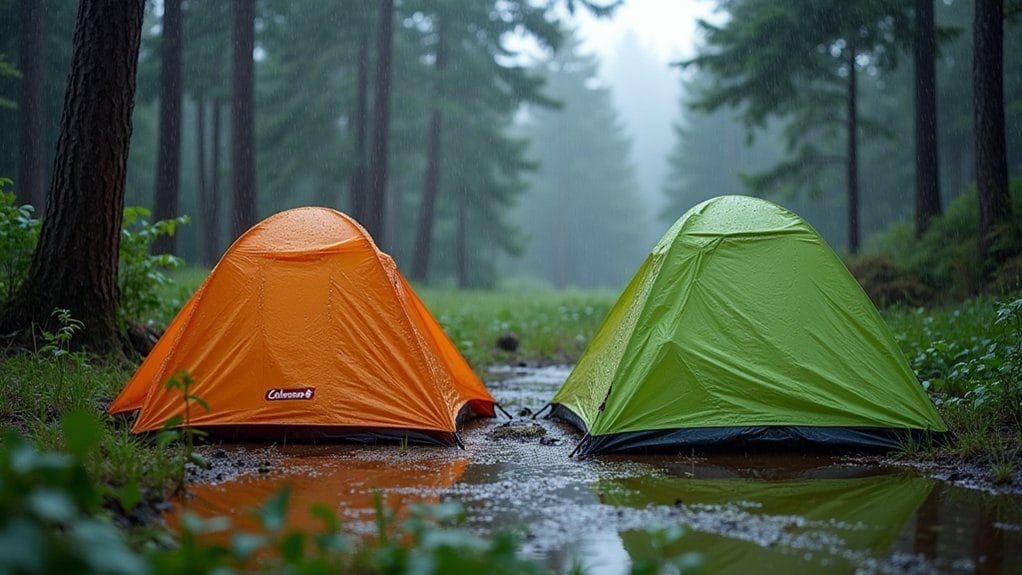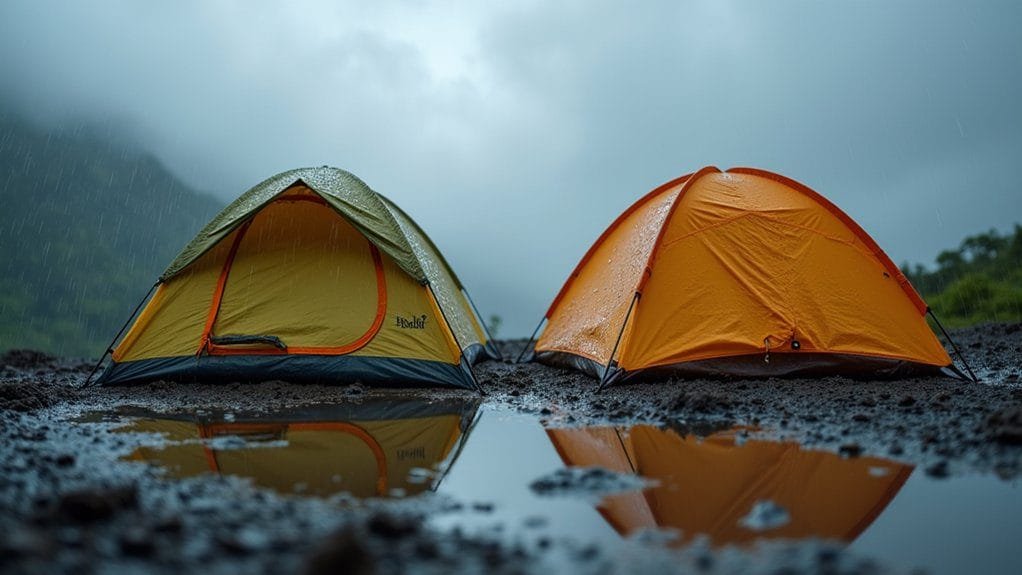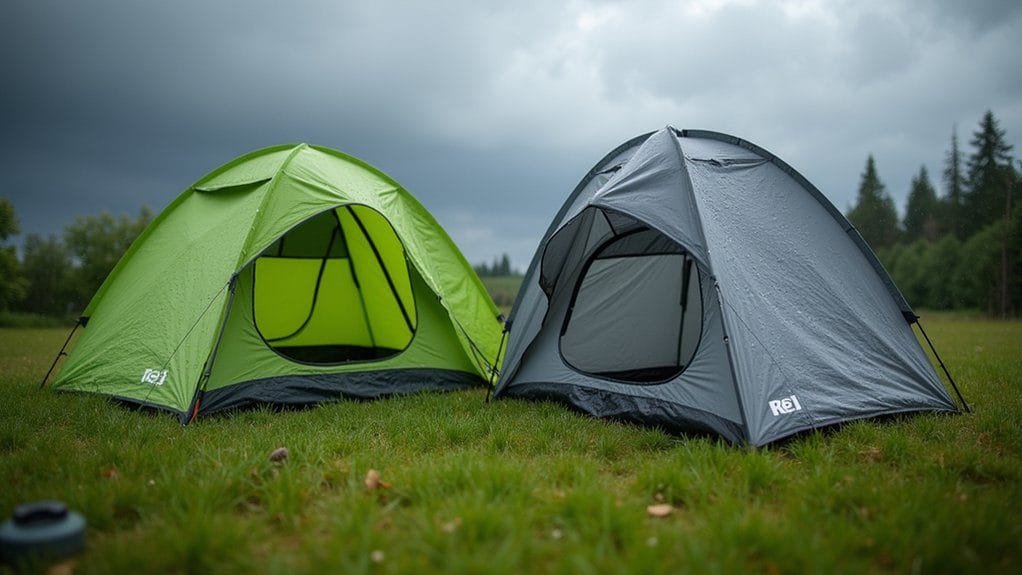When camping in rainy conditions, you’ll want a tent with superior waterproofing. REI tents outperform Coleman models with hydrostatic head ratings over 1,200mm, full-length rainflies, and robust seam taping. The REI Base Camp 6 can withstand 10 hours of intense precipitation, while Coleman’s Sundome struggles after just 3 hours. Your choice impacts comfort and gear protection—stick around to uncover the nuanced differences in rain-ready tent technologies.
Key Takeaways
- REI tents consistently outperform Coleman in rainy conditions, with hydrostatic head ratings exceeding 1,200mm compared to Coleman’s minimal 450-1,000mm range.
- The North Face Wawona 6 and REI Base Camp 6 demonstrate superior water resistance, surviving multiple days of continuous rainfall without leakage.
- Full-length rainflies on REI models provide comprehensive moisture protection, extending to the ground and blocking water intrusion more effectively than Coleman’s partial covers.
- Premium REI tents feature advanced seam taping and strategic engineering, preventing water penetration and managing condensation better than budget Coleman alternatives.
- While Coleman tents offer lower initial costs ($150-$230), REI’s higher-priced models ($549) deliver significantly more reliable waterproofing and long-term weather protection.
Why Waterproofing Matters in Camping Tents


Because water can quickly turn a camping trip from enjoyable to miserable, understanding tent waterproofing is critical for outdoor enthusiasts. Effective waterproofing prevents leaks during heavy rain, with a minimum hydrostatic head rating of 1,000mm recommended for reliable water resistance. Key features like full-length rainfly and extensive seam taping greatly enhance waterproof performance in camping tents.
Higher-end tent models, such as the REI Co-op Base Camp 6 and The North Face Wawona 6, demonstrate superior waterproofing through quality materials and construction. These designs incorporate advanced ventilation systems that minimize condensation, addressing the common issue of trapped humid air. Budget models often lack these essential waterproofing elements, leaving campers vulnerable to unexpected moisture and potential discomfort during wet weather conditions.
Comparing Coleman and REI Tent Waterproof Technologies
When evaluating waterproof technologies in camping tents, the performance differences between Coleman and REI become starkly apparent. Coleman’s hydrostatic head ratings (450-1,000mm) suggest minimal water resistance, increasing vulnerability to leaks during heavy rain. REI tents, conversely, feature superior waterproof technologies with ratings exceeding 1,200mm, ensuring extensive protection.
Critical distinctions emerge in rainfly design and seam sealing. REI’s full-length rainflies extend to the ground, blocking water intrusion, while Coleman’s partial rainflies leave critical areas exposed. Seam sealing represents another key differentiator: REI’s meticulous approach prevents water penetration, whereas Coleman’s limited seam taping compromises tent performance. These technological variations directly impact your camping experience, determining whether you’ll stay dry or find yourself unexpectedly soaked during wet outdoor conditions.
Detailed Performance Analysis in Wet Conditions


Although rigorous field testing reveals critical differences in tent waterproofing performance, the data exposes nuanced variations across brand technologies. When comparing the REI Base Camp 6 and Coleman Sundome, you’ll find stark contrasts in heavy rain test results. The REI tent’s full-length rainfly and meticulous seam sealing enable it to withstand 10 hours of intense precipitation, while the Coleman model struggles after just 3 hours. The North Face Wawona 6 emerges as another top performer, surviving three days of continuous rainfall without leakage, thanks to its robust gear storage design and thorough waterproof construction. For family camping tent selection, prioritize models with superior seam sealing and hydrostatic head ratings to guarantee reliable protection against unexpected wet conditions. Waterproof performance isn’t just about material—it’s about strategic design and rigorous engineering.
Key Features for Rain Protection
Rain’s relentless assault demands strategic tent design that goes beyond basic waterproofing. When evaluating rain protection, you’ll want to focus on critical features like full-length rainflies, seam taping, and hydrostatic head ratings that determine water resistance. REI tents excel with thorough moisture shields, offering extensive seam taping that prevents water intrusion and protecting your inner tent space during heavy rain.
Key considerations include vestibule space for gear storage and ventilation systems that manage condensation. While Coleman tents often fall short, high-performance models like the REI Base Camp 6 provide 31 sq ft of protected area, allowing you to keep equipment dry. Robust ventilation prevents moisture buildup, ensuring your shelter remains comfortable and leak-free in challenging wet conditions. Prioritizing these technical design elements will greatly enhance your tent’s rain performance.
Price and Value Comparison


Three key price points emerge when comparing tent options for rainy weather: budget, mid-range, and premium models. If you’re seeking value, the Coleman Skydome XL 8 at $230 offers budget-friendly space, while sacrificing some weatherproofing performance. In contrast, the REI Co-op Base Camp 6 at $549 represents a premium investment with superior rainfly coverage, ventilation, and durability. While the Coleman Sundome 6 under $150 provides minimal rain protection, the REI model’s robust construction and larger vestibule area justify its higher price. When evaluating gear storage and long-term reliability, the REI tent delivers better performance in challenging weather conditions. Your choice depends on balancing immediate cost with anticipated rainproofing needs and potential replacement expenses.
Real-World Testing Results
When evaluating waterproof tent performance, real-world testing reveals essential insights into how different models manage moisture under challenging conditions. Coleman tents typically struggle with rain protection, lasting only 30-60 minutes in heavy rainfall, while REI models demonstrate superior waterproof capabilities. The North Face Wawona 6 and REI Base Camp 6 excel through thorough seam taping and extended rainfly designs, mitigating minor leaks from unsealed seams. You’ll notice significant differences in gear storage and water resistance between budget and premium models. REI tents consistently outperform Coleman in real-world performance, with longer rainflies that extend to the ground and provide enhanced moisture protection. Understanding these nuanced differences helps you select a tent that’ll keep you dry during intense weather conditions, making informed decisions vital for outdoor enthusiasts seeking reliable shelter.
Expert Recommendations for Rainy Camping Environments
Because severe weather demands strategic camping gear selection, outdoor experts consistently recommend prioritizing waterproof tent features when preparing for rainy environments. Focus on hydrostatic head ratings above 1,000mm and full-length rainfly designs like the REI Co-op Base Camp 6 and North Face Wawona 6 to guarantee maximum rain protection. Avoid water-resistant tents with partial rainflies, such as the Coleman Sundome 6, which are prone to leaks during heavy rain. Pay attention to critical details like sealed seams, integrated vestibules for wet gear storage, and thorough guyline systems. When selecting a tent for challenging camping environments, prioritize models with proven water resistance, robust construction, and extensive waterproofing technologies to prevent moisture infiltration and maintain interior dryness during prolonged rainfall conditions.
Frequently Asked Questions
What Type of Tent Is Best in the Rain?
You’ll want a tent with a full-length rainfly, high hydrostatic head rating (1,000mm+), thorough seam sealing, strategic ventilation, and a quality footprint to effectively manage moisture and provide superior weather resistance in rainy conditions.
Are Coleman Tents Good in Rain?
Coleman tents aren’t ideal for heavy rain. Their limited waterproof ratings (450-1000mm) and partial rainflies mean you’ll likely experience water intrusion within 30-60 minutes. You’ll need seam sealing and careful maintenance to improve rain performance.
What Is the Highest Waterproof Tent?
The North Face Wawona 6 stands out with its 1,500mm floor and 1,200mm body waterproof ratings. Its superior seam sealing, full-coverage rainfly, and strategic ventilation make it the highest-rated waterproof tent for preventing moisture intrusion during intense rainfall.
What Is the Best Material for Tents in the Rain?
You’ll want polyester with a high hydrostatic head rating, full-length rainfly, and proper seam sealing. Opt for coatings like silicone or polyurethane, ensuring breathable fabric with robust ventilation to manage condensation during heavy rain performance.
Which Tent Is Better for Rainy Backpacking Trips: Coleman or REI?
When selecting the perfect tent for rainy backpacking trips, both Coleman and REI offer excellent options. Coleman tents often provide durability and weather resistance at an affordable price. Meanwhile, REI tents excel in lightweight designs and waterproof materials, making them ideal for hikers who prioritize gear efficiency and reliability in wet conditions.
Conclusion
When you’re choosing between Coleman and REI for rainy camping, your decision hinges on technical waterproofing performance. Coincidentally, as you compare their technologies, you’ll find REI’s superior fabric treatments and seam-sealing provide more reliable protection. Both brands offer robust options, but REI’s precision engineering gives it a slight edge in wet environments. Your ultimate selection depends on specific trip conditions and budget constraints.



